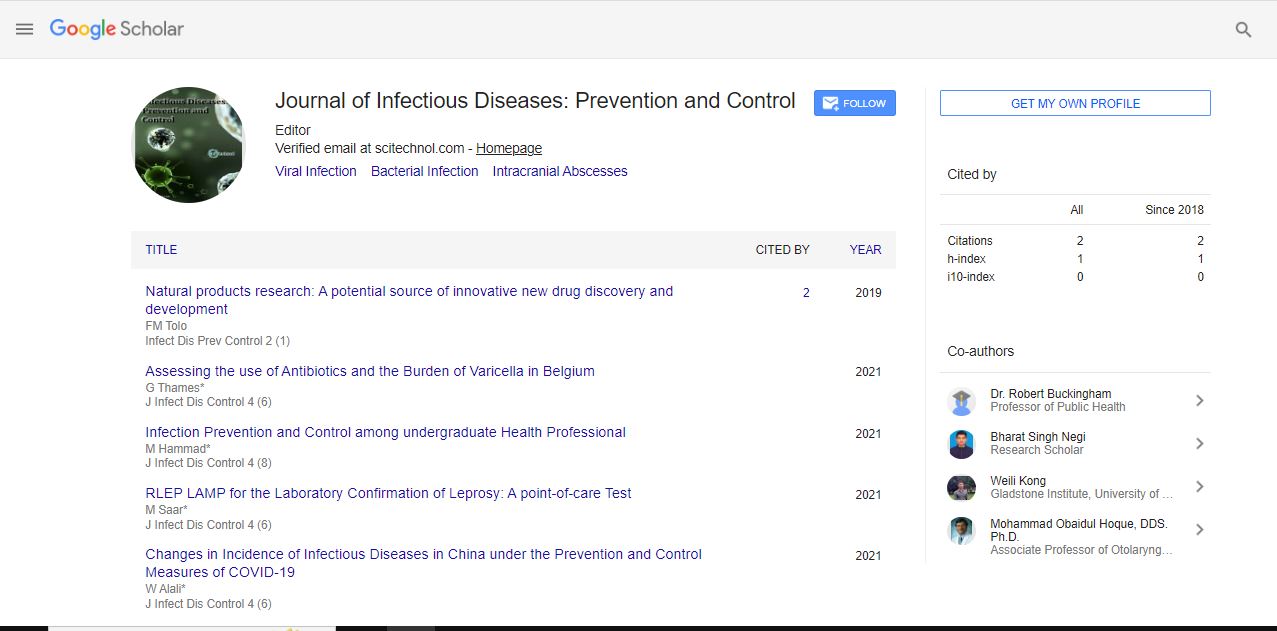Perspective, Vol: 6 Issue: 2
Intracranial Abscesses: Etiology, Clinical Presentation, Diagnosis and Management
Kiran Kumar*
1Department of Infectious Diseases, Meenakshi Mission Hospital & Research Centre, Madurai, India
*Corresponding Author: Kiran kumar,
Department of Infectious Diseases,
Meenakshi Mission Hospital & Research Centre, Madurai, India
E-mail: kiran2462@gmail.com
Received date: 27 May, 2023, Manuscript No. IDPC-23-105455;
Editor assigned date: 29 May, 2023, Pre QC No. IDPC -23-105455(PQ);
Reviewed date: 15 June, 2023, QC No. IDPC -23-105455;
Revised date: 23 June, 2023, Manuscript No. IDPC -23-105455 (R);
Published date: 30 June, 2023, DOI: 10.36648/idpc.5.2.133
Citation: Kumar K (2023) Intracranial Abscesses: Etiology, Clinical Presentation, Diagnosis and Management. Infect Dis Prev Control 6:2.
Abstract
Intracranial abscesses are serious and potentially life-threatening infections characterized by the formation of a localized collection of pus within the brain parenchyma or the surrounding meninges. The intracranial abscesses, including their etiology, clinical presentation, diagnostic approaches, and management strategies. Early recognition and prompt intervention are crucial to minimize morbidity and mortality associated with these challenging infections
Description
Intracranial abscesses are serious and potentially life-threatening infections characterized by the formation of a localized collection of pus within the brain parenchyma or the surrounding meninges. The intracranial abscesses, including their etiology, clinical presentation, diagnostic approaches, and management strategies. Early recognition and prompt intervention are crucial to minimize morbidity and mortality associated with these challenging infections.
Intracranial abscesses represent a significant neurological emergency that requires timely diagnosis and management. The significance of comprehending the causes, clinical manifestations, diagnostic techniques, and management plans for cerebral abscesses. The various etiological factors contributing to the development of intracranial abscesses. The most common causative agents include bacteria, such as Staphylococcus aureus and Streptococcus species, as well as fungi and, rarely, parasites.
The manuscript discusses the routes of infection, including direct spread from a nearby focus of infection or hematogenous dissemination. A detailed description of the clinical manifestations of intracranial abscesses is provided in this section. Patients often present with fever, malaise, and chills, indicating an ongoing infection.
Severe and persistent headaches are a frequent complaint, often localized to the site of the abscess. Depending on the abscess's location, patients may experience focal neurological deficits such as weakness, sensory disturbances, or impaired coordination. Confusion, disorientation, and altered consciousness can result from increased intracranial pressure and brain inflammation. Intracranial abscesses can provoke seizures, ranging from focal to generalized in nature.
Accurate and timely diagnosis of intracranial abscesses is crucial for appropriate management. Computed Tomography (CT) and Magnetic Resonance Imaging (MRI) scans are essential in identifying abscesses and determining their size, location, and characteristics. Lumbar puncture may be performed to diagnose associated meningitis, but it is often deferred if increased intracranial pressure is suspected. Culturing pus aspirated from the abscess can identify the causative microorganisms, guiding appropriate antibiotic therapy.
The management of intracranial abscesses requires a multidimensional approach involving medical therapy, surgical intervention, and supportive care. Empirical broad-spectrum antibiotics are initiated as soon as possible and later based on culture results. Intravenous antibiotics are typically administered for several weeks. Large abscesses or those with significant mass effect may require surgical drainage. This can be achieved through stereotactic aspiration or open craniotomy, depending on the abscess's characteristics. If increased intracranial pressure threatens the patient's well-being, interventions such as osmotic therapy and cerebrospinal fluid drainage may be employed. Treating the underlying source of infection, such as sinusitis or endocarditis, is important to prevent recurrence. Highresolution imaging techniques, such as functional MRI and diffusionweighted imaging, will enhance diagnostic accuracy and aid in identifying early-stage abscesses. Advancements in minimally invasive surgical techniques may reduce the invasiveness and risks associated with abscess drainage.
 Spanish
Spanish  Chinese
Chinese  Russian
Russian  German
German  French
French  Japanese
Japanese  Portuguese
Portuguese  Hindi
Hindi 